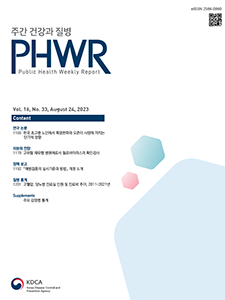Current Issue
Vol.16 No.33, August 24, 2023
-
Original Articles 2023-08-24
 2
2
 705
705
 203
203
Study on the Health Effects of Climate Change among the Elderly
Moon-Kyung Shin, Kyoung-Nam Kim, Sanghyuk Bae, Mi-Ji Kim, Jong-Hun Kim, Ho-Jang Kwon, Seung-Sik Hwang, Hyoeun Kim, Younjhin Ahn
Public Health Weekly Report 2023; 16(33): 1165-1177 https://doi.org/10.56786/PHWR.2023.16.33.1 Abstract
AbstractRecent studies have reported that extreme temperatures have a greater impact on health in the elderly (aged 65 and over) than in the non-elderly (under age 65). Recent studies have also reported that increases in the use of outpatient visits and emergency department visits among elderly were found to be associated with the increase of air pollutants and ozone exposure. This study analyze the health effects of climate change in elderly by further subdividing the elderly by age compared to previous studies. This study was used to daily mortality data, the aggregate data obtained through Korean Statistical Information Service. As a result of the analysis, high and low temperatures were associated with an increased risk of mortality due to all-cause and cardiovascular mortality. In addition, the increase in non-accidental and cardiovascular mortality due to ozone exposure was observed only in the 80-year-old or older group. In conclusion, this study confirmed that the levels of health impact associated with climate change are not identical for all the age groups of the elderly group, but they are significantly increased for the oldest-old group.
-
Review & Perspective 2023-08-24
 0
0
 1223
1223
 316
316
Confirmatory Diagnosis of Re-Emerging Filoviruses
Hwachul Shin, Myung-Min Choi, Hwajung Yi, Yoon-Seok Chung*
Public Health Weekly Report 2023; 16(33): 1178-1191 https://doi.org/10.56786/PHWR.2023.16.33.2 Abstract
AbstractEbolavirus and Marburgvirus, part of the filovirus family (Filoviridae), are class 1 infectious diseases that can cause severe hemorrhagic fever in humans and have a high mortality rate of 75% or more. Rapid and accurate diagnosis of filovirus infections is crucial for effective outbreak control and patient management. The gold-standard methods for diagnosing filoviruses are gene detection, antigen test and antibody test. Diagnostic capabilites have improved owing to advancement in point-of-care testing and the use of mobile laboratory facilities, particularly in resource-limited settings. However, challenges associated with development, standardization, and validation of highly sensitive and specific diagnostic tools remain. In this article, we introduce the role of gene and antigen detection tests and serological tests in filovirus diagnosis, and compare and describe the characteristics, strengths, and weaknesses of each of these tests.
-
Policy Notes 2023-08-24
 0
0
 712
712
 216
216
Revision of “Immunization Standard and Method” in the Republic of Korea
In Ju Kang, Hang Jin Jung, Hea Lim Lee, Geun Yong Kwon*
Public Health Weekly Report 2023; 16(33): 1192-1200 https://doi.org/10.56786/PHWR.2023.16.33.3AbstractThe Korea Disease Control and Prevention Agency (KDCA) publishes “Epidemiology and management of vaccine preventable disease” and periodically revises it for effective immunization. The revised edition was renamed “Immunization Standard and Method” to clarify the purpose of publication. The main revisions 1) include new chapters on new infectious diseases, newly developed vaccines, and special matters; 2) reflect the latest epidemiology; 3) apply changed infectious disease diagnosis and reporting standards; 4) partially change immunization standards; and 5) guide for special situations. The KDCA plans to regularly revise “Immunization Standard and Method” to reflect the latest knowledge so that medical personnel and health-related public officials can efficiently and safely perform immunization tasks.
-
QuickStats 2023-08-24
 0
0
 490
490
 190
190
Trends in Hypertension and Diabetes Patients and Medical Expenses, 2011–2021
Public Health Weekly Report 2023; 16(33): 1201-1202 https://doi.org/10.56786/PHWR.2023.16.33.4

pp. 1433~1461
Most Keyword
?
What is Most Keyword?
- It is the most frequently used keyword in articles in this journal for the past two years.
Most Read
-
Waterborne and Foodborne Disease Outbreaks in the Republic of Korea, 2023
Myung-Jae Hwang, So Yeon Park, Hyungjun Kim, Se Jeong Yang, Sungchan Yang, Jin Seon Yang
Public Health Weekly Report 2025;18: 17-32 https://doi.org/10.56786/PHWR.2025.18.1.2 -
Implementation Plan for the Coronavirus Disease 2019 Vaccination for the 2024–2025 Season: Recommendations of the 6th Expert Committee on Immunization Practices
Hyewook Hwang, Wookeon Lee, Seohyeon Ahn, Young-Sook Choi, Seunghyun Lewis Kwon, Dongwoo Lee, Eun Hwa Choi, SokGoo Lee
Public Health Weekly Report 2025;18: 90-102 https://doi.org/10.56786/PHWR.2025.18.2.3
Editorial Office
+82-43-719-7569





 Full Text
Full Text Cite
Cite


